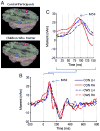Speech-induced suppression of evoked auditory fields in children who stutter
- PMID: 21095231
- PMCID: PMC3042852
- DOI: 10.1016/j.neuroimage.2010.11.026
Speech-induced suppression of evoked auditory fields in children who stutter
Abstract
Auditory responses to speech sounds that are self-initiated are suppressed compared to responses to the same speech sounds during passive listening. This phenomenon is referred to as speech-induced suppression, a potentially important feedback-mediated speech-motor control process. In an earlier study, we found that both adults who do and do not stutter demonstrated a reduced amplitude of the auditory M50 and M100 responses to speech during active production relative to passive listening. It is unknown if auditory responses to self-initiated speech-motor acts are suppressed in children or if the phenomenon differs between children who do and do not stutter. As stuttering is a developmental speech disorder, examining speech-induced suppression in children may identify possible neural differences underlying stuttering close to its time of onset. We used magnetoencephalography to determine the presence of speech-induced suppression in children and to characterize the properties of speech-induced suppression in children who stutter. We examined the auditory M50 as this was the earliest robust response reproducible across our child participants and the most likely to reflect a motor-to-auditory relation. Both children who do and do not stutter demonstrated speech-induced suppression of the auditory M50. However, children who stutter had a delayed auditory M50 peak latency to vowel sounds compared to children who do not stutter indicating a possible deficiency in their ability to efficiently integrate auditory speech information for the purpose of establishing neural representations of speech sounds.
Copyright © 2010 Elsevier Inc. All rights reserved.
Figures








References
-
- Ambrose NG, Cox NJ, Yairi E. The genetic basis of persistence and recovery in stuttering. Journal of Speech, Language, and Hearing Research. 1997;40(3):567–580. - PubMed
-
- Bailly G. Learning to speak. sensori-motor control of speech movements. Speech Communication. 1997;22(2–3):251–267.
-
- Beal DS, Gracco VL, Lafaille SJ, DeNil LF. Voxel-based morphometry of auditory and speech-related cortex in stutterers. NeuroReport. 2007;18(12):1257–1260. - PubMed
-
- Beal DS, Cheyne DO, Gracco VL, Quraan MA, Taylor MJ, De Nil LF. Auditory evoked fields to vocalization during passive listening and active generation in adults who stutter. NeuroImage. 2010;52(4):1645–1653. - PubMed
-
- Biermann-Ruben K, Salmelin R, Schnitzler A. Right rolandic activation during speech perception in stutterers: A MEG study. NeuroImage. 2005;25(3):793–801. - PubMed
Publication types
MeSH terms
Grants and funding
LinkOut - more resources
Full Text Sources
Medical
Research Materials

